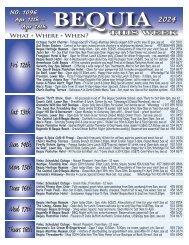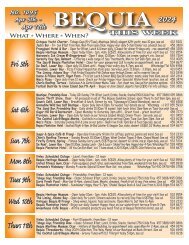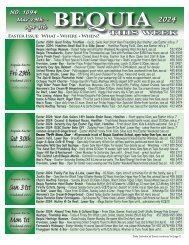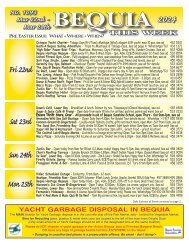Caribbean Compass Yachting Magazine - February 2021
Welcome to Caribbean Compass, the most widely-read boating publication in the Caribbean! THE MOST NEWS YOU CAN USE - feature articles on cruising destinations, regattas, environment, events...
Welcome to Caribbean Compass, the most widely-read boating publication in the Caribbean! THE MOST NEWS YOU CAN USE - feature articles on cruising destinations, regattas, environment, events...
Create successful ePaper yourself
Turn your PDF publications into a flip-book with our unique Google optimized e-Paper software.
— Continued from previous page<br />
On our way ashore the following morning, we met another boatbuilder. Sam<br />
Hermiston was a 12-year-old Scot living board his family’s ketch, which was also<br />
anchored in the harbor. Sam was fishing off the dinghy dock when we pulled up.<br />
“You building a model boat at Benson’s,” he declared in a decided Scots accent,<br />
spying the wood blank in Havana’s hands. “I built one there too.” He reeled in his<br />
fishing line, put down his pole, and off we all went. The boys got on famously,<br />
sharing an interest in models and in boats.<br />
Later that afternoon, we took Sam out to his family’s ketch, Sea Warrior, so he<br />
could show us his model. The small 14-inch model, made from gumwood, had been<br />
hollowed out and decked over, to make it lighter. It was sloop rigged, with a tall mast,<br />
self-tending jib, deep weighted keel and no rudder. Sam climbed into our dinghy, set<br />
his model gently in the water and gave her a shove. Off she went as straight as an<br />
arrow in the ten-knot breeze that ruffled the harbor. The tiny model laid over in the<br />
gusts, righting itself and bobbing along in the chop. As we followed it in our dinghy<br />
the boys were all smiles to<br />
see the small boat flying<br />
along, all by itself: no remote<br />
controls, no battery-powered<br />
motor, just the breeze and<br />
the magic of the boatbuilder’s<br />
craft to harness the wind.<br />
Back at the shop, Havana’s<br />
hull was clamped in the vise<br />
and Benson showed Havana<br />
how to use a hand plane to<br />
complete the job of squaring<br />
off the outline of the<br />
laminated planks. Benson<br />
then drew a line on the hull<br />
where he figured the turn of<br />
the bilge would be, where<br />
the waterline might be. With<br />
his machete, he chopped<br />
away the excess wood creating the rough shape of the boat’s underbody. More<br />
planing as the profile of the boat took shape. Next would be carving away the wood<br />
from stern to the stern to create the completed shape of the hull.<br />
When it was completed, Havana could begin the long, tedious task of sanding the<br />
hull. We tested the hull’s buoyancy in seawater. It sat too low. To lighten the boat,<br />
we’d have to remove wood from inside the hull, and then deck it over. That is, if<br />
Havana wanted his model to actually sail.<br />
“Do you make any models that actually sail?” Havana asked Benson.<br />
“No, but many of the kids do,” he replied. “We have a model boat race here every<br />
year during the Bequia Easter Regatta. Here — I’ll show you one of the winners.”<br />
From off a shelf came a half a coconut, rigged with a mast and long bowsprit and<br />
cotton cloth for sails. “The lads put a few stones in the coconut for ballast.”<br />
But it would be some time before Havana’s boat would feel the wind and taste the<br />
water, as he had a lot of sanding to do. This, to be followed by two coats of primer,<br />
sanding between each coat, then two to three coats of topside paint, then bottom<br />
paint, a boot stripe and deck paint. The mast and boom needed to be shaped, and<br />
then stays and shrouds and halyards rigged. Lifelines? Deck hardware might be<br />
added, and finally the name needed to be painted on the stern.<br />
As we cruised farther through the <strong>Caribbean</strong> islands, Havana was busy sanding<br />
the hull and designing the rig and deck layout for his model boat, often taking an<br />
idea here and there from the yachts we passed or that anchored next to us.<br />
Whether his model ever made it into the water or not wasn’t as important as the<br />
Above: Models of whaleboats and large yachts share a counter in the showroom.<br />
Left: Sam with his model that sails.<br />
lessons he would learn along the way. The patience it takes, and the skill of hand<br />
and tool that Benson imparted, along with the feel of the wood — it’s the process<br />
not the product that teaches.<br />
Later, while spending a month in English Harbour on Antigua, we visited the local<br />
shipyard and had a piece of sheet aluminum cut out for the keel. A nearby wood<br />
working shop cut out a piece of scrap mahogany plywood for the deck. But it wasn’t<br />
until we returned to Maine that Havana fished his model.<br />
She did sail once, but she was a bit too tender. She needed to be lightened more,<br />
and more weight added to the bottom of the keel for stability.<br />
Havana’s model sits here in our Maine house, a reminder that his ideas can be made<br />
real. All it takes is patience and acquiring skills, and those he is now learning. He’s now<br />
20, off to Solent University in the UK, studying marine engineering and yacht design.<br />
FEBRUARY <strong>2021</strong> CARIBBEAN COMPASS PAGE 23

















